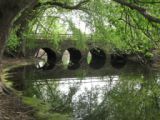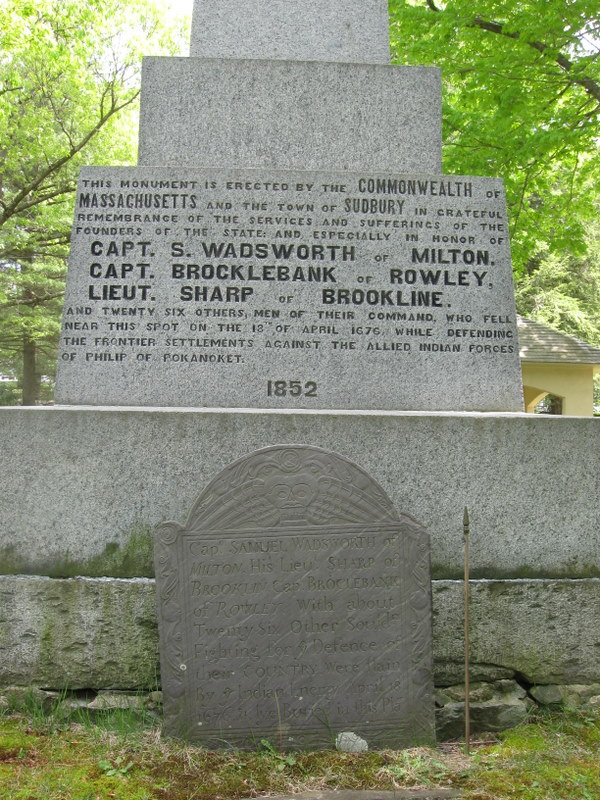FATHER OF DANIEL AXTELL
Son of *Thomas Axtell 1619-1646 and *Mary Rice
Siblings: Mary Axtell, Lydia Axtell 1644-
Married *Hannah Merriam Jun 14, 1665
Children: Samuel Axtell 1666- , Hannah Axtell 1667- , Mary Axtell 1670- , Thomas Axtell 1672-1750, *Daniel Axtell 1673-1734, Sarah Axtell 1675
*My grandparents
Henry Axtell was killed during King Philip's War in 1676 in Sudbury MA. One account states he was killed within a couple weeks of the town being attacked as he worked in his fields, other accounts place him in or near Sudbury around April 19-21, 1676. What is sure is that Henry Axtell died among many others and was buried in an ummarked grave near Wadsworth cemetery where 29 soldiers were also buried and a memorial to those who died during those attacks stands today.
The bridge was located a short distance north of the present bridge carrying Old Sudbury Road over the Sudbury River. The Native American attackers used this bridge to attack the east side of Sudbury (the present Town of Wayland).The more heavily populated eastern part of Sudbury was defended by the bulk of the eighty-man Sudbury militia.
The militia would have been active in protecting the fortified church/meeting house near the bridge since it was the principal Town storehouse for emergency supplies of guns, shot, and gunpowder, and it also served as a place of refuge for civilians at times of attack.
The militia was able to protect the east-side civilians and some of their property, but they did not have sufficient manpower to force the Native American attackers back across the bridge.
The roughly 200 hostile Native Americans did not go long distances from the bridge during their destructive raids on the eastern side of the river, since they needed to be able to retreat quickly back to the western part of Town if major military assistance from other Towns arrived.
However, some structures in the far western part of what is now the Town of Weston were burned by the hostile Native Americans.
A group of soldiers from Watertown did arrive in the middle of the day, and the combined force of these soldiers and the Sudbury militia was able to drive the hostile Native Americans back across the bridge into the western part of the Town.
Excerpt written by InSearchOf from a description of the battle from town of Sudbury MA US website and the Soldiers in King Philip's War by George Madison Bodge
FATHER OF DANIEL AXTELL
Son of *Thomas Axtell 1619-1646 and *Mary Rice
Siblings: Mary Axtell, Lydia Axtell 1644-
Married *Hannah Merriam Jun 14, 1665
Children: Samuel Axtell 1666- , Hannah Axtell 1667- , Mary Axtell 1670- , Thomas Axtell 1672-1750, *Daniel Axtell 1673-1734, Sarah Axtell 1675
*My grandparents
Henry Axtell was killed during King Philip's War in 1676 in Sudbury MA. One account states he was killed within a couple weeks of the town being attacked as he worked in his fields, other accounts place him in or near Sudbury around April 19-21, 1676. What is sure is that Henry Axtell died among many others and was buried in an ummarked grave near Wadsworth cemetery where 29 soldiers were also buried and a memorial to those who died during those attacks stands today.
The bridge was located a short distance north of the present bridge carrying Old Sudbury Road over the Sudbury River. The Native American attackers used this bridge to attack the east side of Sudbury (the present Town of Wayland).The more heavily populated eastern part of Sudbury was defended by the bulk of the eighty-man Sudbury militia.
The militia would have been active in protecting the fortified church/meeting house near the bridge since it was the principal Town storehouse for emergency supplies of guns, shot, and gunpowder, and it also served as a place of refuge for civilians at times of attack.
The militia was able to protect the east-side civilians and some of their property, but they did not have sufficient manpower to force the Native American attackers back across the bridge.
The roughly 200 hostile Native Americans did not go long distances from the bridge during their destructive raids on the eastern side of the river, since they needed to be able to retreat quickly back to the western part of Town if major military assistance from other Towns arrived.
However, some structures in the far western part of what is now the Town of Weston were burned by the hostile Native Americans.
A group of soldiers from Watertown did arrive in the middle of the day, and the combined force of these soldiers and the Sudbury militia was able to drive the hostile Native Americans back across the bridge into the western part of the Town.
Excerpt written by InSearchOf from a description of the battle from town of Sudbury MA US website and the Soldiers in King Philip's War by George Madison Bodge
Family Members
Advertisement
Records on Ancestry
Sponsored by Ancestry
Advertisement






